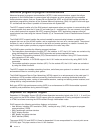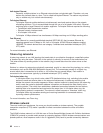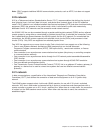Half-duplex Ethernet
Generally, multiple stations in an Ethernet network show a single data path. Therefore, only one
station may transmit data at a time. This is called half-duplex Ethernet. The station may transmit
only or receive only, but not both simultaneously.
Full-duplex Ethernet
Full-duplex Ethernet enables stations to simultaneously send and receive data on the network,
eliminating collisions. This is accomplished through the use of a full-duplex LAN switch. Ethernet
switching splits a large Ethernet into smaller segments. Full-duplex Ethernet requires the following:
v Twisted-pair cable transmission medium
v Ethernet network interface cards
v A full-duplex LAN switch
Full-duplex 10 Mbps ethernet has simultaneous 10 Mbps receiving and 10 Mbps sending paths.
Fast Ethernet
Fast Ethernet is a recently established standard (IEEE 802.3U) that increases Ethernet by
operating speeds from 10 Mbps to 100, half or full duplex. AS/400 Ethernet adapters support
100BASE-TX network devices that use category 5 shielded and unshielded twisted-pair (STP,
UTP) cable.
For more information, see Ethernet.
Token-ring networks
A token-ring network is one LAN topology that sends data in one direction throughout a specified number
of locations by using the token. The token is the symbol of authority for control of the transmission line.
This token allows any sending station in the network (ring) to send data when the token arrives at that
location.
Stations in a token-ring network are physically connected, usually in a star-wired ring topology, to a wiring
concentrator such as the IBM 8228 Multistation Access Unit. The concentrator serves as a logical ring
around which data is transmitted at 4 million or 100 million bits per second (Mbps). Each station is
connected to the concentrator typically by shielded twisted pair (STP) cabling.
Full-duplex token ring
In full-duplex token ring, which is also called DTR (dedicated token ring), switching hubs enable
stations to send and receive data on the network simultaneously. A token-ring switching hub
divides the network into smaller segments. When a station transmits its data packet, the token-ring
switch reads the packet’s destination address information and forwards the data directly to the
receiving station. The switch then establishes a dedicated connection between the two stations,
enabling data to be transmitted and received at the same time. In full-duplex token ring, the
token-passing protocol is suspended. The network in effect becomes a ’tokenless’ token ring.
Full-duplex token ring increases sending and receiving bandwidth for connected stations,
improving network performance.
For more information, see Token ring.
Wireless network
The more mobile your employees, the more you should consider a wireless network. The portable
transaction computers (PTCs) make it possible for direct connection between the office and offsite
locations.
The AS/400 wireless network is a LAN that uses a Carrier Sense Multiple Access with Collision Avoidance
(CSMA/CA) protocol to provide media access to competing stations. AS/400 wireless communications use
spread-spectrum, direct sequence radio in the 2.4 gigahertz (GHz) band to provide connectivity between
92 Version 5


















